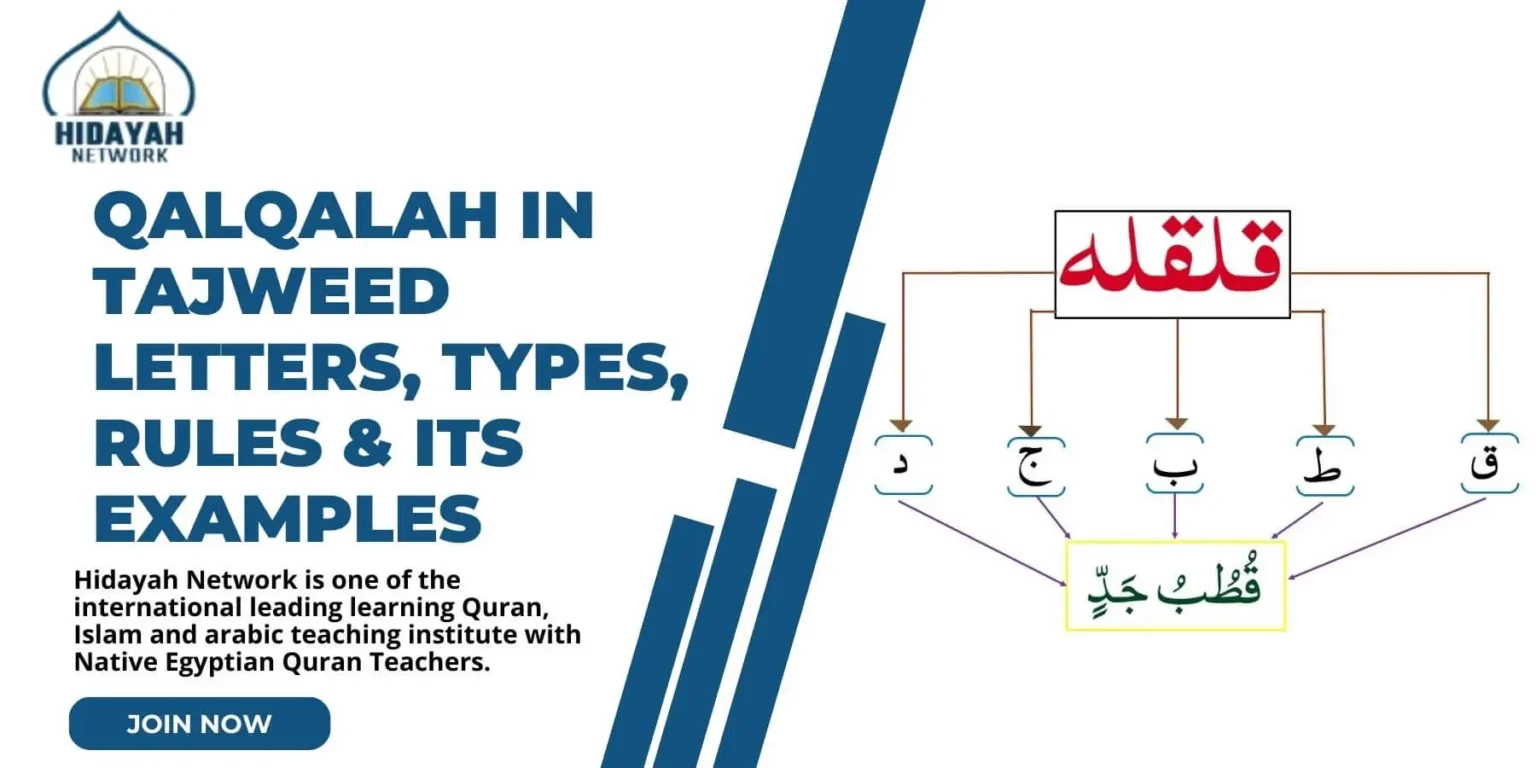When it comes to the Tajweed, there are many important things to learn about how to read the Quran beautifully and correctly. One of these important things is called Qalqalah. Understanding Qalqalah helps us to pronounce these letters correctly and make the Quran sound even more beautiful.
Qalqalah is an echoing sound in Tajweed. It helps us to give a special emphasis to certain letters when we recite the Quran. Learning about Qalqalah is essential for anyone who wants to read the Quran with proper pronunciation. So, if you’re curious about how to make your recitation even more beautiful and accurate, let’s explore Qalqalah with examples and its different types with different rules.
Table of Contents
ToggleWhat is Qalqalah in Tajweed?
In tajweed rules, Qalqalah is a crucial concept for accurately reciting the Quran. Essentially, when certain letters have a Sukoon (a symbol indicating no vowel sound), they produce a reverberating or echoing sound known as Qalqalah. This echoing effect serves to emphasize these letters and make their pronunciation clearer. Qalqalah isn’t just about correct pronunciation; it also enhances the beauty and rhythm of Quranic recitation.
As you understand and apply Qalqalah correctly, readers can ensure that their recitation of the Quran is both accurate and musical in accordance with the principles of Tajweed. So, Qalqalah plays a significant role in preserving the integrity and musicality of Quranic recitation.
Qalqalah Letters
| Letter | Description of Qalqalah |
| ق (Qaf) | When pronounced with Sukoon, Qaf produces an echoing effect, contributing to the rhythm and clarity of Quranic recitation. An example is the word “مقْمحون” (maqmuhoon), where the echoing effect can be heard on the letter ق. |
| ط (Ta) | Ta is considered the strongest Qalqalah letter. When pronounced with Sukoon, it creates a powerful echoing effect, enhancing the emphasis and pronunciation of words. For instance, in the word “نطْفة” (natafah), the echoing of the letter ط is prominent. |
| ب (Ba) | Qalqalah in the letter ب produces a light bouncing sound when spoken with Sukoon. This bouncing effect adds a subtle emphasis to the pronunciation of words, as seen in examples like “يبْصرون” (yabṣaroon). |
| ج (Jeem) | Similar to ب, the letter ج creates a slight bounce when pronounced with Sukoon. This bouncing effect contributes to the rhythmic flow of recitation, as demonstrated in words like “أجْر” (ajr). |
| د (Dal) | When pronounced with Sukoon, the letter د vibrates slightly, producing a gentle echoing effect. This effect helps to maintain the musicality and clarity of Quranic recitation, as observed in the word “لقدْ” (laqad). |
Note: Hidayah Network teachers teach qalqalah letters in our online tajweed course for proper Quran recitation with tajweed.
Get 40% OFF Now!
Types of Qalqalah
1. Qalqalah Sughra (Lesser)
Qalqalah Sughra occurs when any of the Qalqalah letters is found in the middle of a word, resulting in a weak echoing of the letter. For instance, in “khalaqna (خَلَقْنَا)”, the letter “ق” in the middle demonstrates weak Qalqalah. Similarly, in “tat-heeran (تطْهِيرًا)”, the letter “ط” in the middle follows this pattern.
The word “abnaa’akum” also shows this, with the letter “ب” in the middle, all with sukoon signs. In such cases, the echoing is weak, and one proceeds directly to the rest of the word, ensuring smooth and accurate recitation.
2. Qalqalah Wusta (Intermediate)
Qalqalah Wusta occurs when one of the Qalqalah letters comes at the end of a word without a shaddah. In this case, the echoing of the letter is somewhere between the strong and weak types. For example, in “qad aflaha (قَدْ أَفْلَحَ)”, the letter “د” at the end of the word without a shaddah sign exemplifies intermediate Qalqalah.
Similarly, in “najid lahu (نَجِدْ لَهُ)”, the letter “د” at the end of the word without a shaddah sign follows this pattern. This intermediate rule ensures proper pronunciation and maintains the rhythmic flow of the recitation, striking a balance between the strong and weak forms of Qalqalah.
3. Qalqalah Kubra (Greater)
Qalqalah Kubra occurs when any of the Qalqalah letters appears at the end of a word or at the end of a verse with a shaddah, and if one stops at it, the echoing of the letter becomes strong. For instance, in the word “Al-falaq (الْفَلَقِ)”, the letter “ق” is at the end of the word, causing a strong Qalqalah. Similarly, in “Kasab (كَسَبَ)”, the letter “ب” at the end exemplifies this type of Qalqalah.
Words like “Muheet (مُحِيطٌ)” ending with “ط”, “Masad (مَسَدٍ)” ending with “د”, and “Al-ma’aarij (الْمَعَارِجِ)” ending with “ج” demonstrate this pattern. Although some readers may not stop at the end of a verse, diacritics are employed to indicate the strong Qalqalah. Nevertheless, it’s advisable to pause at each verse’s end to ensure proper pronunciation and emphasize the Qalqalah.
Rules of Qalqalah in Tajweed
Here are eight Qalqalah rules that you must know:
- Qalqalah happens when one of five letters (ق, ط, ب, ج, د) has no vowel sound on it, called a Sukoon.
- The strength of Qalqalah varies: ط has the strongest, while ق, ب, ج, and د have progressively lighter effects.
- Qalqalah is more noticeable when the letter is followed by another letter.
- If a Qalqalah letter has a vowel (like fatha, kasra, dummah, or tanween), there’s no Qalqalah.
- If a Qalqalah letter with Sukoon is followed by another letter with Sukoon, the Qalqalah is longer.
- A Qalqalah letter with a shaddah (double consonant) has a stronger echoing effect.
- When two Qalqalah letters appear together, the echoing sound intensifies.
- Pronounce Qalqalah letters clearly and accurately to maintain proper Tajweed application.
Examples of Qalqalah with Its Letters in the Quran
Example of the Qaf letter in the Quran:
In Surah Ya-Sin (36:8), Allah says, “{إِنَّا جَعَلْنَا فِي أَعْنَاقِهِمْ أَغْلَالًا فَهِيَ إِلَى الْأَذْقَانِ فَهُم مُّقْمَحُونَ}”. The word “مُّقْمَحُونَ” demonstrates Qalqalah on the letter Qaf at the end. This echoing effect adds emphasis to the word and enhances the beauty of recitation.
Example of the Taa letter in the Quran:
In Surah Ya-Sin (36:77), Allah states, “{أَوَلَمْ يَرَ الْإِنسَانُ أَنَّا خَلَقْنَاهُ مِن نُّطْفَةٍ فَإِذَا هُوَ خَصِيمٌ مُّبِينٌ}”. The word “نُّطْفَةٍ” exemplifies Qalqalah on the letter Taa at the end. This echoing effect aids in pronunciation and adds a musical quality to the recitation.
Example of the Baa letter in the Quran:
In Surah Ya-Sin, Allah commands, “{وَاضْرِبْ لَهُم مَّثَلًا أَصْحَابَ الْقَرْيَةِ إِذْ جَاءَهَا الْمُرْسَلُونَ}”. The word “وَاضْرِبْ” demonstrates Qalqalah on the letter Baa at the end. This bouncing sound adds clarity to the pronunciation and emphasizes the word’s meaning.
Example of the Jeem letter in the Quran:
In Surah Ya-Sin (36:38), Allah mentions, “{وَالشَّمْسُ تَجْرِي لِمُسْتَقَرٍّ لَّهَا ذَلِكَ تَقْدِيرُ الْعَزِيزِ الْعَلِيمِ}”. The word “تَجْرِي” showcases Qalqalah on the letter Jeem at the end. This echoing effect enriches the recitation and adds a melodic touch to the verse.
Final Words
Hidayah Network provides an Online Quran Recitation Course and an Advanced Tajweed Course for students aiming to improve their Quranic recitation. These courses are meticulously crafted to guide learners in understanding and implementing Tajweed principles, including the intricate technique of Qalqalah.
Qalqalah adds a unique dimension to Quranic verses, emphasizing certain letters and enriching the overall experience of reading and listening to the Quran. Through diligent practice and adherence to Tajweed principles, individuals can ensure that their recitation honors the sacred text with clarity and reverence. Embrace Qalqalah as a tool to deepen your connection with the Quran and elevate your recitation to new heights of excellence and spirituality.

About Author

